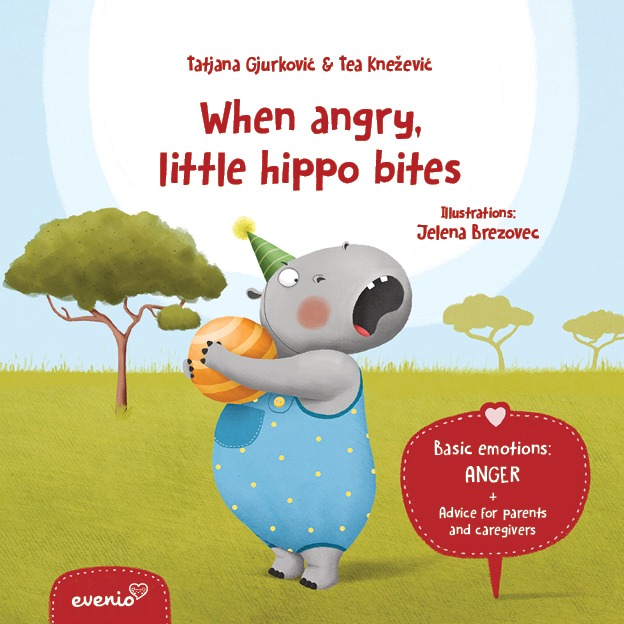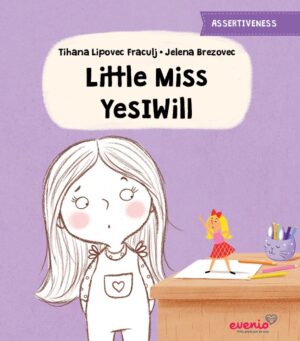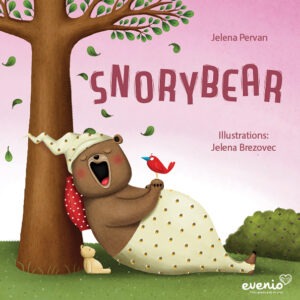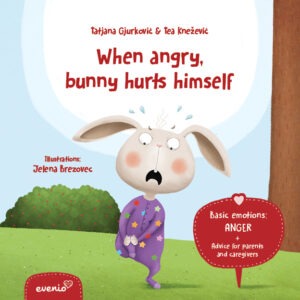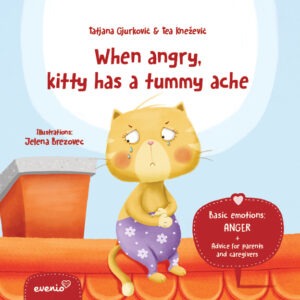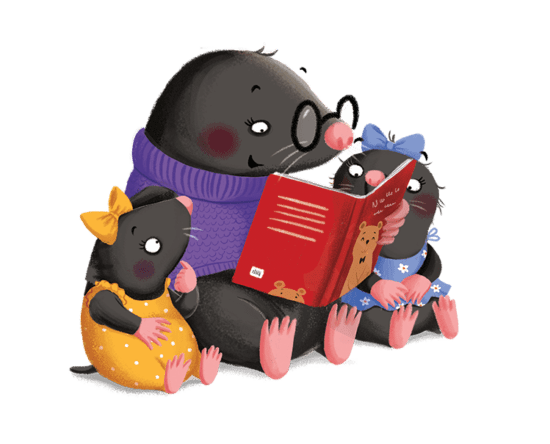When angry, little hippo bites
Basic emotions: ANGER
| Author | Tatjana Gjurković, Tea Knežević |
|---|---|
| Illustrator | Jelena Brezovec |
| Original Title | Kad je ljut, nilski konjić grize |
| ISBN | 978-953-8008-67-2 |
| Format | softcover |
| Pages | 24 |
| Size | 22x22 cm |
| Age range | Early learning (2 – 6), Beginning readers (5 – 7) |
Get in touch
We can’t wait to explore new opportunities together!
| Category | Anger |
|---|---|
| Tag | Basic emotions: ANGER |
WRITTEN BY EXPERTS IN CHILD PSYCHOLOGY
Little hippo couldn’t wait to celebrate his fifth birthday! Of all the gifts he received, he was most pleased with the new ball. It was his favourite toy. After opening the presents, he wanted to be the first to play with the new ball, but the ball disappeared! When he saw that his tiger friend took the ball without asking, the hippo got very angry and bit his paw. Fortunately, there was a wise owl living nearby who helped them calm their feelings and resolve the conflict in a peaceful and friendly manner.
This story is part of therapeutic picture book series about anger in children. It deals with the problem of expressing anger through aggressive behaviour towards others.
Anger belongs to so-called – basic emotions. Basic emotions appear in all cultures and can be seen in babies from birth. By the end of the 6th month of life, child expresses all four basic emotions (anger, fear, happiness and sadness).
Anger is an emotion extremely focused on others, it can be very strong and intense, and it seeks to be expressed “outwardly”. It manifests itself through changes in the body which encourage tension and more impulsive behaviors. As it is much easier to notice a child’s behavior than his emotions, adults are often not aware that behind unwanted behavior are a child’s unfulfilled emotional needs.
Very often, children don’t know how to recognize and process feelings of anger or frustration, which results in aggressive behaviour. At an early age, it can be hitting, biting, scratching, pushing other children or adults. Sometimes the aggression is (also) verbal, so the child will say bad words to others.
The story helps children to recognize and name their own emotions, work through stressful situations and satisfy the need behind the emotion of anger.
Book also contains guidelines and advice for parents and caretakers that will help them better understand child’s behaviour, teach him to manage his behaviour and self-regulate unpleasant emotions.

Author: Tatjana Gjurković
Tatjana Gjurković has a master’s degree in psychology, she is certified psychotherapist, certified child play therapist (RPT), Certified Transactional Analyst (CTA), Teacher and Supervisor of Transactional Analysis (TSTA). She works individually with children and adults and holds educational programs for specialists in fields of child play therapy and transaction analysis. She is author of a book “Play Therapy with children” and 28 therapeutic picture books. She continuously promotes the importance of mental health in children and adults through Centar Proventus which she co-founded with her colleague Tea Knežević.

Author: Tea Knežević
Tea Knežević has master’s degree in psychology, she is certified psychotherapist, certified child play therapist (RPT) and Certified Transactional Analyst (CTA). She provides play therapy with children, psychotherapy with adults, parent consultations, and conducts numerous training courses for professionals in Centar Proventus which she co-founded with her colleague Tatjana Gjurković. She has written 28 picture books with therapeutic stories for children. In addition, she is the author of several manuals related to psychological resilience, gifted children, and anger management.

Illustrator: Jelena Brezovec
Jelena Brezovec has a master’s degree in social studies. For a long time, drawing was just a hobby, until 2008 when she became a co-founder of the publishing house Evenio and decided to study digital illustration, with the focus on children’s illustration. So far, she has illustrated more than 40 picture books and many other publications. She is the winner of the Grigor Vitez “Bird” Award, a special praise from the children’s jury. She has illustrated the most popular children’s book series in Croatia – Mrljek & Prljek. Her illustrations have been part of many exhibitions throughout Croatia. She lives and works in Varaždin, Croatia.

